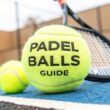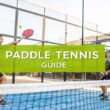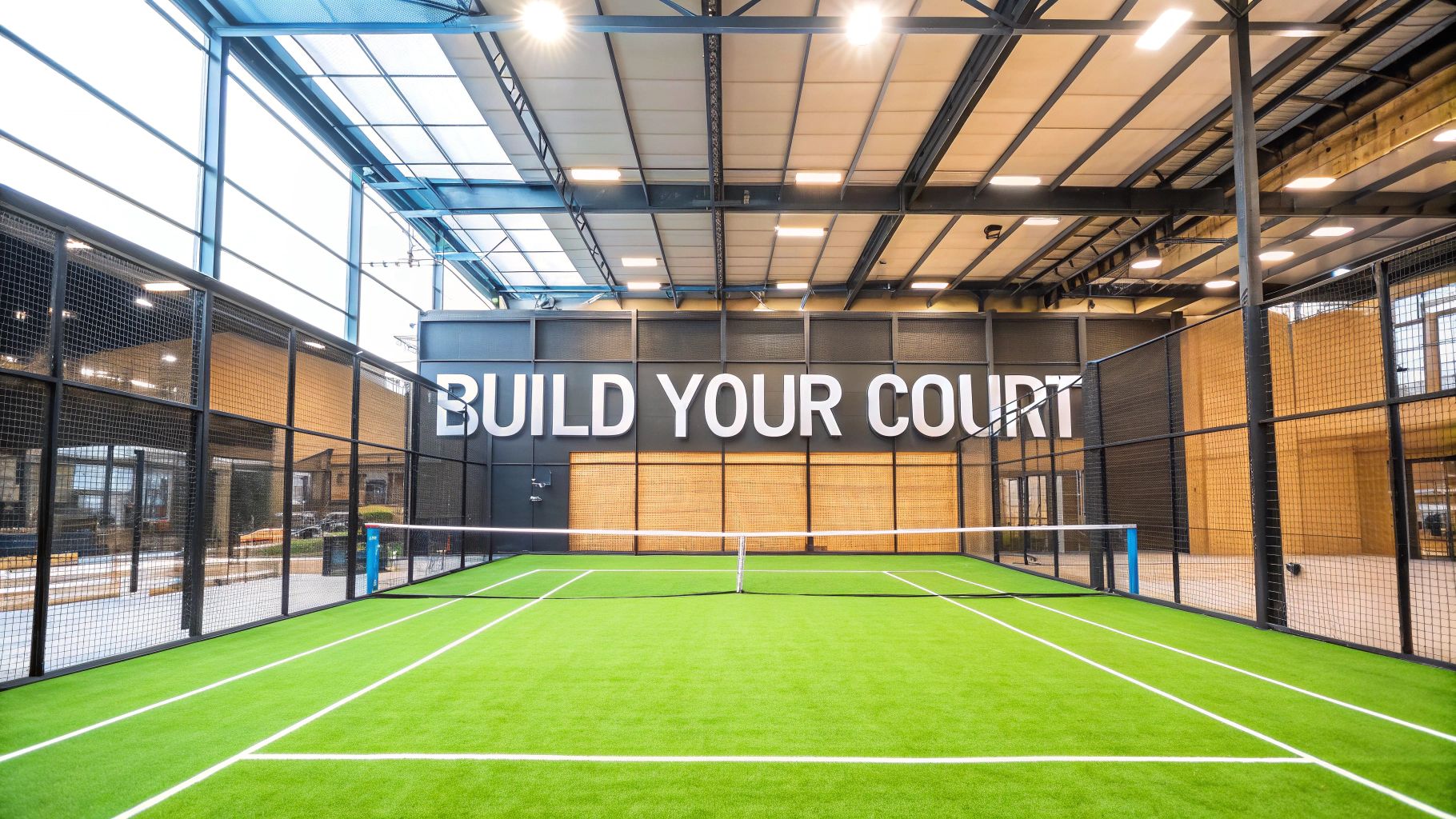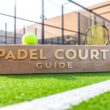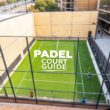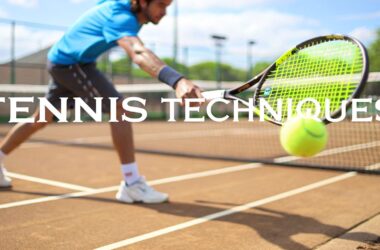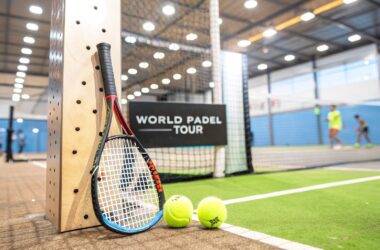If you're thinking about investing in padel courts, going the indoor route isn't just following a trend—it's a smart business move. The biggest win? Year-round playability. This guarantees a steady income stream no matter what the weather is doing outside, a massive advantage that outdoor courts just can't match.
The Undeniable Appeal of Indoor Padel Courts
Padel's explosive growth is more than a fad; it's a real shift in how people want to spend their free time. For any investor or club owner, understanding what's driving this demand is the first step to cashing in on the opportunity. The magic of indoor padel lies in a powerful mix of market realities and what players are looking for.
At its heart, the indoor model cracks the biggest problem any outdoor facility faces: the weather. Rain, snow, blistering heat, or crazy winds can wipe out a full day of bookings, leaving you with no income and unhappy players. An indoor facility sidesteps all of that. You get a reliable, climate-controlled space that keeps people playing and leagues running all year long.
Maximizing Revenue and Player Access
This 24/7/365 availability is the bedrock of a stronger, more predictable business. You can confidently book leagues, corporate events, and casual matches months out without a single thought about cancellations. That consistency is a game-changer compared to seasonal sports. For a deeper dive into the court itself, check out our guide on what a padel court is and its essential components.
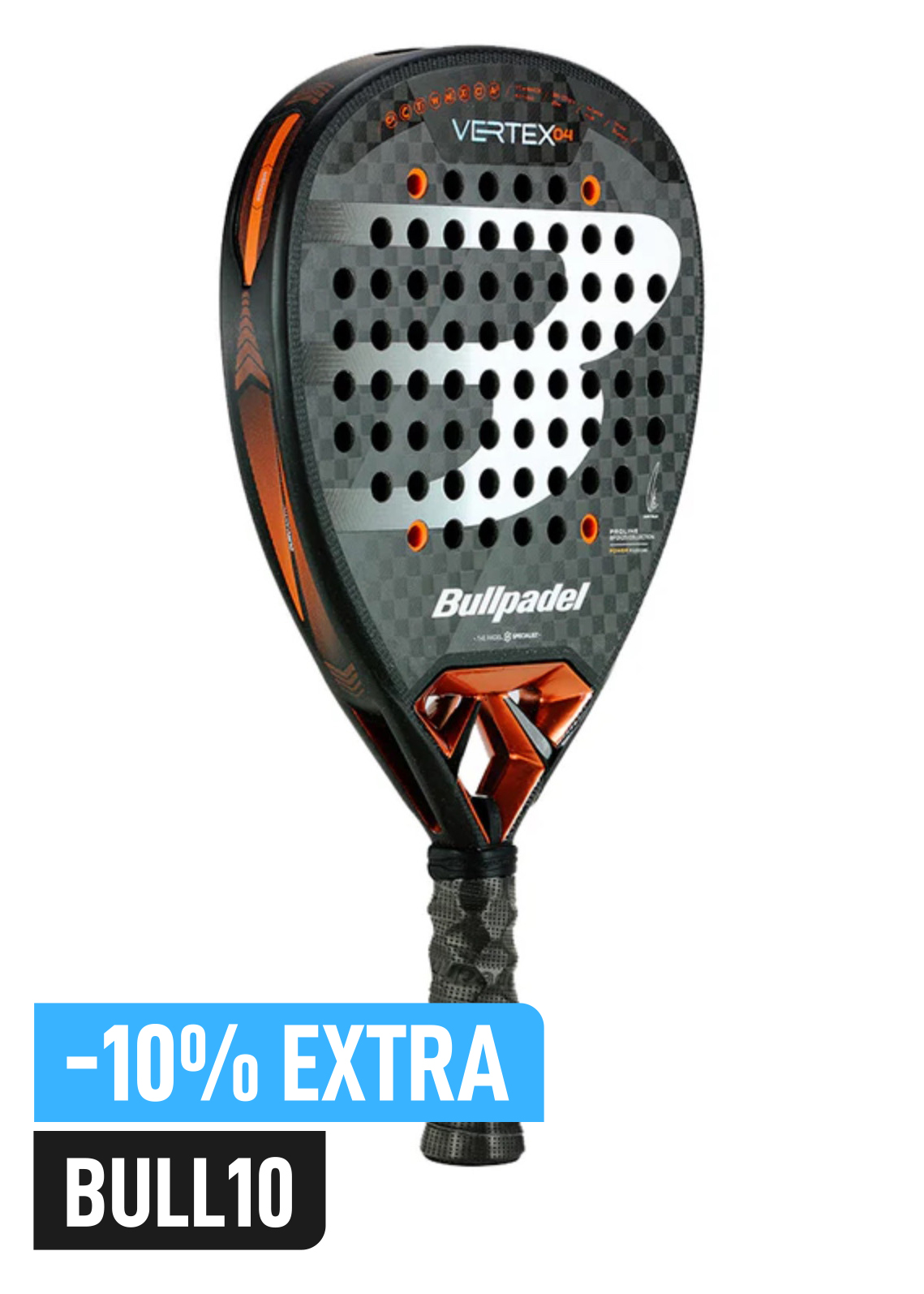
Buy the best padel gear to level up your next game!
CHECK OUT this deal from Padel Market!Get ready to take your game to the next level with the latest padel gear from Padel Market! Fast EU and Worldwide Shipping
Beyond just weather-proofing your business, indoor courts are a perfect fit for modern cities. Space is tight in urban areas, making it tough to find land for new outdoor sports facilities. But indoor venues? They can be slotted into old warehouses or industrial buildings, turning underused spaces into profitable clubs.
Padel’s growth isn't slowing down. Its social, easy-to-learn nature makes it incredibly sticky, while the move indoors makes it accessible to a much wider audience, creating a perfect storm for investment.
A Global Phenomenon Driving Local Demand
The sport's worldwide expansion is all the proof you need of its staying power. We just saw over 7,000 new padel courts built across the globe in a single year, bringing the total to more than 50,000. That’s a 17% annual increase, fueled by an average of nine new clubs opening their doors every single day.
While places like Sweden and Italy have been hotbeds for a while, the trend is now hitting emerging markets hard. This signals padel's shift from a European niche to a true global sport. This international momentum creates powerful ripples, driving demand for top-notch, easy-to-access facilities—like indoor courts—right in your own backyard. You can get more insights on this global boom over at SquashFacilities.com.
Your Padel Court Project Blueprint
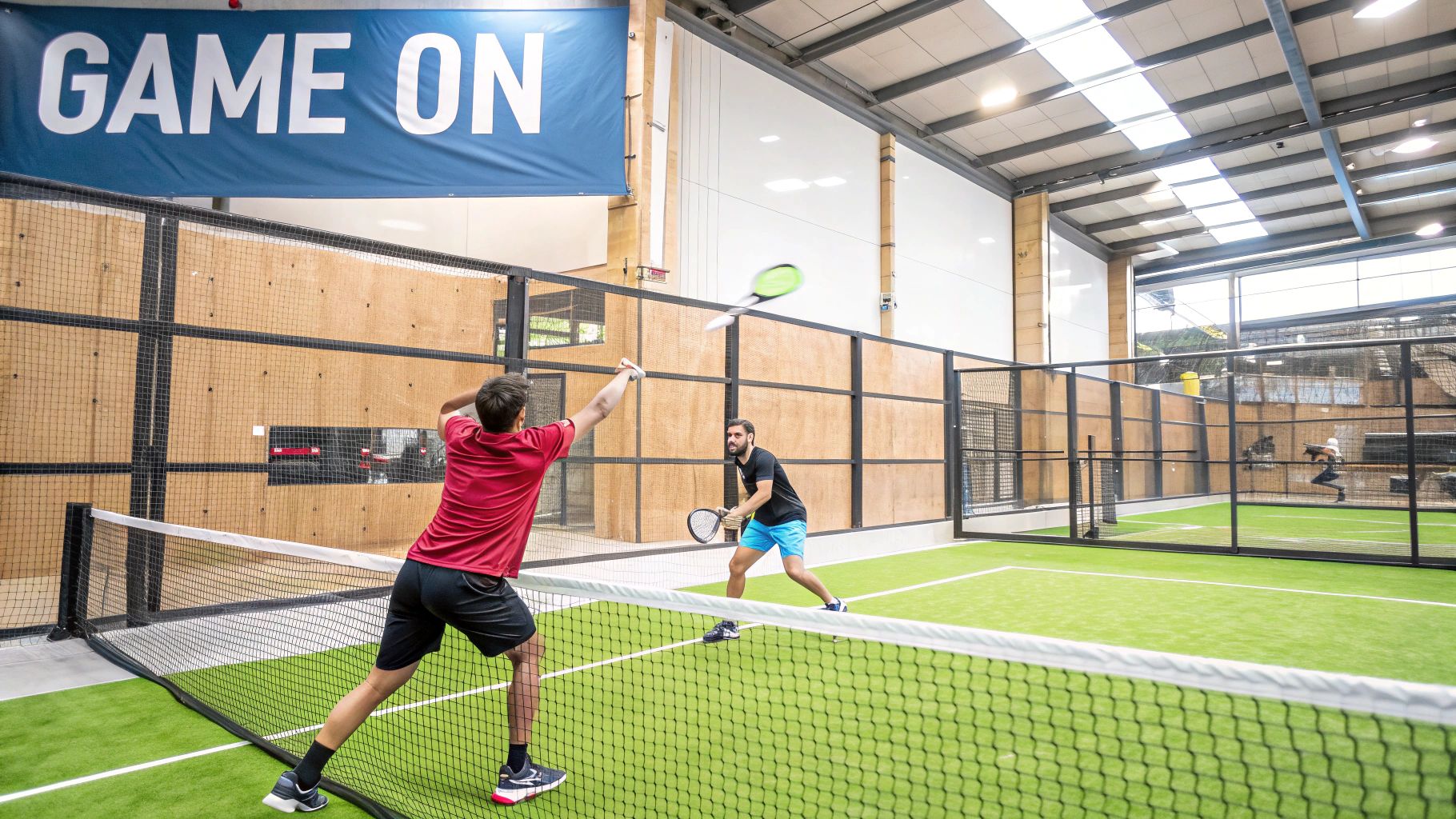
Before you even think about breaking ground or signing a lease, the single most important thing you can do is create a detailed blueprint. Think of this as the foundation for your entire project. A solid plan will help you dodge costly mistakes and ensure your indoor padel courts are set up for success right from the start. This early phase covers it all—from scouting the perfect spot to nailing down the final court layout.
The first, and arguably most critical, decision you'll make is site selection. The right location can absolutely make or break your business. It's easy to get tempted by a building with cheap rent, but trust me, other factors are far more crucial for the long-term health of your padel club. You need to be focused on accessibility, local demand, and the physical specs of the building itself.
Finding The Ideal Location
When you're checking out potential sites, put yourself in a player's shoes. How easy is it to get there? Is there enough parking? Being close to residential areas, business parks, or other sports complexes can give you a built-in customer base from day one. Do your homework on the local demographics to make sure there's a real appetite for a new sports venue.
The building itself has some non-negotiable requirements, and ceiling height is usually the biggest deal-breaker. To give players a professional and enjoyable experience, you need a clear, unobstructed height over the entire playing surface.
- Minimum Recommended Height: You should be looking for at least 8 meters (about 26 feet) of clear height.
- Ideal Height for Competition: If you want a more premium feel or plan to host tournaments, 10-12 meters (33-39 feet) is what you should aim for.
This height is essential for players to hit high lobs without the ball smacking the ceiling—a key part of padel strategy. A low ceiling will only frustrate players and limit the level of play your facility can host.
I’ve seen it happen too many times: operators underestimate the total space they need. You have to account for runoff areas, spectator seating, walkways, and amenities. A cramped facility not only feels unprofessional but can be a serious safety hazard.
Beyond the height, you’ll need to dig into local zoning laws and building codes. Turning an old warehouse or industrial space into a recreational facility almost always requires specific permits. Get in touch with the local authorities early on. It will save you from major headaches and delays later. A solid 'Project Blueprint' relies heavily on comprehensive construction drawings to make sure every detail is accurate.
Adhering To Official Court Dimensions
Once you've got a promising site, it's time to plan the layout. The dimensions for a padel court are strictly defined by the International Padel Federation (FIP) to keep the game consistent everywhere. Sticking to these standards is non-negotiable if you want your club to be taken seriously.
A standard padel court is a rectangle, 20 meters long and 10 meters wide. A net splits the court into two perfect 10×10 meter squares. These are the dimensions for the playing area itself.
But the total footprint for each court is bigger. You must factor in space for the structure and safe runoff zones around the edges. I recommend a minimum of 1-2 meters of clear space around the entire court for player movement and access.
For a deeper dive into the specifics, it's worth reading more about what an indoor padel court really requires, from the structure to all the player amenities.

Buy the best padel gear to level up your next game!
CHECK OUT this deal from Padel Market!Get ready to take your game to the next level with the latest padel gear from Padel Market! Fast EU and Worldwide Shipping
Planning A Player-Centric Layout
A great facility is about so much more than just the courts. Your layout needs to put the entire player experience first. Think about how people will move between courts, the reception area, and the changing rooms.
Here are a few things to map out:
- Spectator Viewing: Where will people watch? Make sure viewing areas don't block walkways or create safety problems. Raised platforms or a mezzanine level can offer fantastic sightlines.
- Player Amenities: Place your changing rooms, restrooms, and water stations where they're easy to get to without disrupting games that are in progress.
- Social Spaces: Padel is an incredibly social sport. Adding a small café, a lounge area, or a pro shop can massively boost the community vibe and open up new revenue streams.
By mapping all these elements out in your initial blueprint, you're not just building a compliant and safe facility—you're creating a place that's welcoming and fun for every single person who walks in. This kind of thoughtful planning is the real first step toward building a thriving padel community.
Choosing Materials For Performance And Durability
When you're building an indoor padel court, the materials you choose are everything. This isn't just about making the court look good; it's a critical investment that will directly impact player experience, safety, and your long-term maintenance costs. Getting this part right sets the foundation for a successful facility.
The heart of the player experience really starts with the artificial turf under their feet. It's the playing surface that dictates the speed of the game, how the ball bounces, and how comfortable players feel making quick moves. You’re essentially choosing between two main types of synthetic grass, and each one creates a totally different game.
Selecting The Right Playing Surface
For a high-performance court, monofilament turf is usually the way to go. Its individual fibers stand up straight, which creates a fast and incredibly consistent surface. This is what you want for competitive leagues and tournaments where players expect a true, predictable ball bounce and the ability to move quickly.
On the other hand, you have fibrillated turf. These fibers are designed to split and fray over time, which creates a much denser, interwoven surface. This tends to slow the game down a bit. While it's often a more budget-friendly option upfront, it can be a headache to maintain and often needs replacing sooner than a quality monofilament turf.
Regardless of the grass, the sand infill is just as important. Silica sand is carefully spread across the turf to hold it down, keep the fibers upright, and—most importantly—fine-tune the ball's speed and bounce. The right amount and quality of sand are non-negotiable for a professional-level court. If you want to dive deeper into how all these elements work together, you can learn more about the padel ball and its unique physics.
Key Takeaway: Don't skimp on the turf and sand. A cheap surface leads to unpredictable bounces, a higher risk of injuries, and a constant maintenance battle. A quality surface is probably the single biggest factor in keeping players coming back.
The image below gives you a solid visual of the standard court dimensions you'll be working with. It's a great reference for picturing the space your materials will fill.
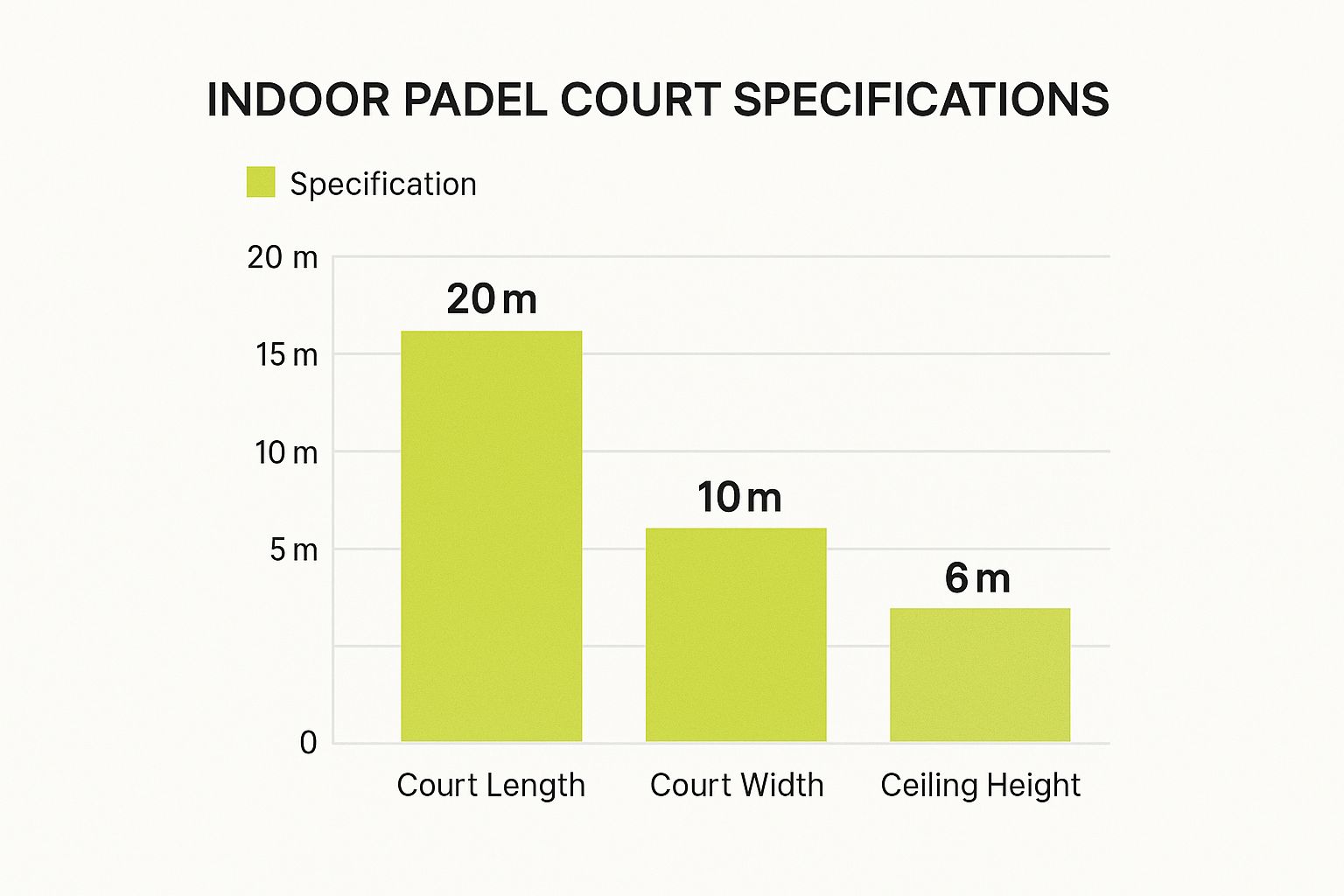
These core numbers—20 meters long, 10 meters wide, and at least 6 meters high—are the blueprint for any regulation indoor padel court.
Structural Components That Ensure Safety And Longevity
Beyond the turf, the structure itself is what guarantees safety and durability. Those iconic glass walls and steel mesh fences aren't just boundaries; they're an active part of the game.
The glass walls absolutely must be made from tempered glass. They need to handle serious impacts from both players and hard-hit balls. You'll typically choose between two thicknesses:
- 10mm Tempered Glass: This is a solid, cost-effective choice for most recreational clubs. It's perfectly safe and performs well for everyday play.
- 12mm Tempered Glass: This is the premium option, and it's what you'll find in high-end facilities and tournament venues. The extra thickness provides superior strength, better sound dampening, and just feels more solid during play.
If you're considering a "panoramic" court with fewer posts for a better view, you'll almost certainly need 12mm glass to handle the extra structural stress on each panel.
The steel frame and mesh are just as crucial. Make sure the frame is galvanized steel to prevent rust—even indoors, humidity can be a problem. The mesh needs to be rigid enough to give a consistent rebound when the ball hits it, with no sagging or loose spots. I always tell people to look closely at the quality of the welds and the finish on the steel. Those small details are a dead giveaway of the manufacturing quality and how long the court will last.
Finally, don't forget the little things. The net posts, gate, and door handles need to be tough enough for constant use. A wobbly net post or a cheap gate latch can make a fantastic court feel poorly made.
To help you budget, here’s a quick comparison of the material choices you’ll be making.
Indoor Padel Court Component Comparison
| Component | Standard Option | Premium Option | Key Consideration |
|---|---|---|---|
| Playing Surface | Fibrillated Turf | Monofilament Turf | Monofilament offers better performance and longevity for serious play. |
| Glass Walls | 10mm Tempered Glass | 12mm Tempered Glass | 12mm is a must for panoramic courts and adds a premium feel. |
| Frame | Galvanized Steel | Stainless or Specially Coated Steel | Galvanized is essential for rust prevention; premium adds aesthetics. |
| Lighting | Standard LED (4-8 fixtures) | High-Output, Glare-Free LED | Premium lighting improves visibility and reduces eye strain for players. |
Once you’ve got a good idea of the materials you want, using a construction material cost predictor can be a huge help in pulling together an accurate budget for all these crucial parts.
Illuminating Your Court for Perfect Play
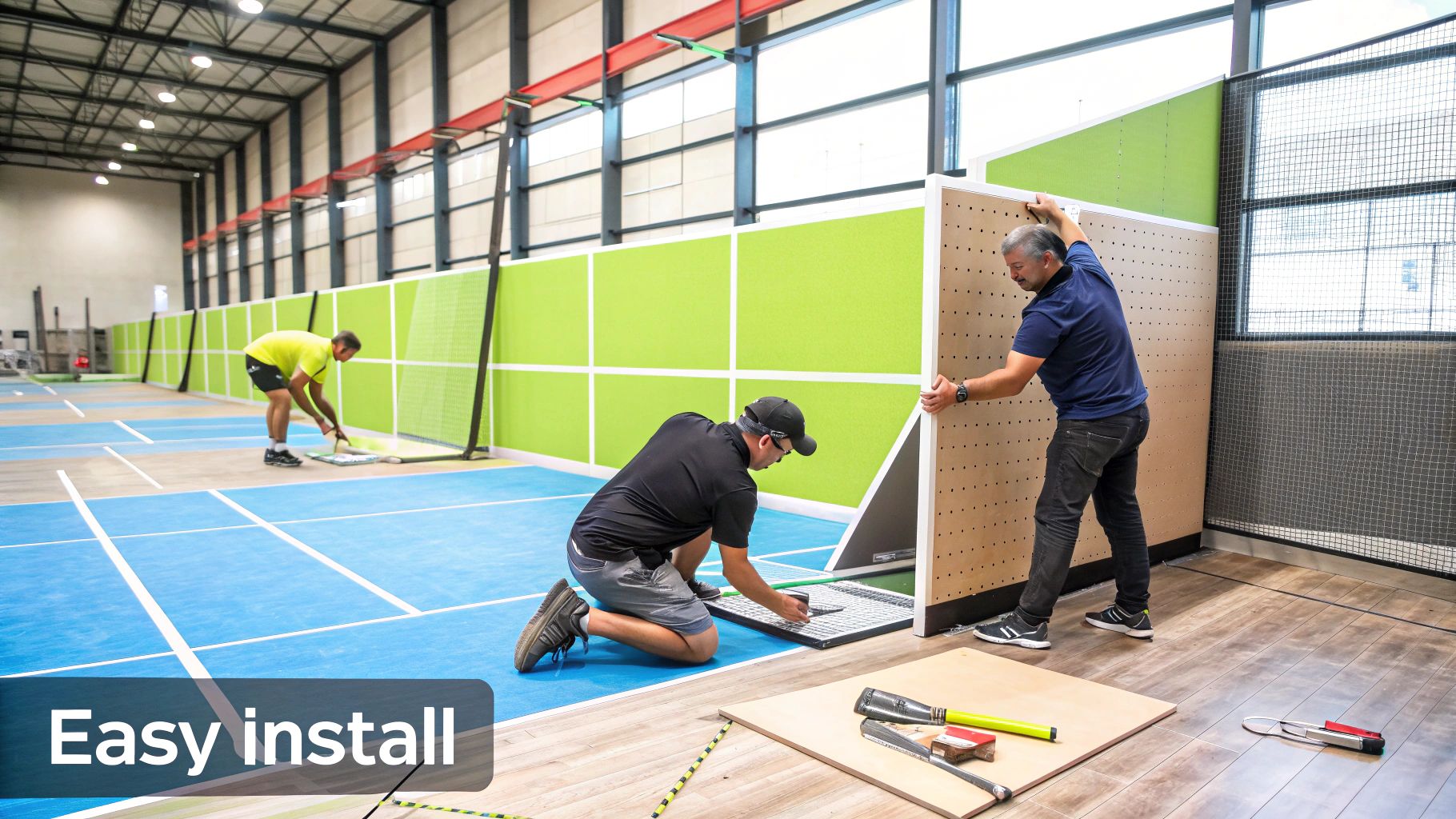
Let's be clear: excellent lighting isn't just a nice-to-have for an indoor padel court. It's an absolute necessity. It has a direct impact on everything from player safety and performance to the overall professional vibe of your entire facility.
Think of it like this—players need to track a lightning-fast ball, read its spin, and anticipate ricochets off the glass walls in a split second. Poor lighting makes that impossible. Glare, dark corners, and shadows create a frustrating experience at best, and a dangerous one at worst. Getting the lighting and climate control right from day one is what separates a forgettable court from a premier padel destination.
Achieving Optimal Lighting Levels
The real trick is to bathe the court in bright, uniform light without blinding the players. We measure this brightness in a unit called lux. The amount of lux you need really depends on who will be using the court.
- Recreational Play: For your everyday club matches, leagues, and casual games, aiming for 300-400 lux is the sweet spot. This provides plenty of clear visibility for fun, competitive play without the intensity (and cost) of a broadcast-ready setup.
- Competitive & Professional Play: If you're looking to host tournaments or attract high-level players, you need to step it up. The standard here is 500 lux or more. This level guarantees perfect ball tracking for high-speed action and is a requirement for most officially sanctioned competitions.
The challenge isn't just hitting a certain number; it's achieving that brightness consistently across every square inch of the court. You have to eliminate any "hot spots" or shadowy patches. This consistency ensures the ball is just as visible in a deep corner as it is at the net or during a high smash.
Modern Lighting Technology And Placement
These days, LED lighting is the undisputed king for indoor sports facilities, and padel is no exception. While the upfront cost might be a bit more than older options like metal halide, the long-term savings are enormous. LEDs consume far less power (a huge win for your electricity bill) and have incredibly long lifespans, which means less maintenance and fewer headaches changing bulbs.
Now, where you put the lights is just as important as what kind of lights you use. A classic mistake I see is installing fixtures directly over the playing area. This seems logical, but it forces players to look right into a bright light when tracking a lob, which is incredibly distracting.
A much better approach is to place the lights along the sides of the court, just outside the main playing footprint. By angling them correctly, you can light up the court beautifully without causing any direct glare for the players. For a standard court, you can typically achieve fantastic results with 8 high-quality LED fixtures.
Controlling The Climate For Player Comfort
One of the biggest draws of indoor padel is the promise of a perfectly controlled playing environment. No one wants to play in a stifling, humid box or a freezing cold warehouse. This is where your Heating, Ventilation, and Air Conditioning (HVAC) system becomes a massive selling point.
A good HVAC system is about more than just temperature. It’s crucial for maintaining great air quality, constantly circulating fresh air, and pulling out the stale, humid air that builds up during intense play.
Put yourself in the players' shoes. A comfortable temperature makes the game more enjoyable, encouraging people to play longer and come back more often. Proper ventilation is also key for managing condensation on the glass walls—a common problem that can seriously interfere with play. Investing in solid climate control isn't just a luxury; it's fundamental to creating the kind of professional, healthy environment that players will happily pay a premium for.
Breaking Down Your Financial Investment
Alright, let's get real about the money. Building an indoor padel court isn't just about buying a "kit." To make a smart investment, you need to look at the complete financial picture—from the big upfront costs to the little things that keep the lights on.
Think of it in a few different buckets: the initial capital you'll need to get the doors open, and the ongoing operational costs that will determine your long-term profitability. Getting a firm handle on both will save you a world of headaches down the road.
The Upfront Capital Investment
Your single biggest expense is, of course, the court itself. And just like buying a car, the price can swing wildly based on the model and features you choose. You can definitely get started with a solid, no-frills court, but a premium setup with all the bells and whistles will naturally command a higher price tag.
So, what should you budget for the court kit (which usually means the turf, glass, and steel frame)?
- Standard Court: You're looking at a range of $18,000 to $25,000. This gets you a perfectly good court, typically with 10mm glass and quality fibrillated or basic monofilament turf. It’s a workhorse and a fantastic choice for most recreational clubs.
- Premium Panoramic Court: These start around $26,000 and can go up to $40,000+. For that, you get the top-tier upgrades: thicker 12mm tempered glass, the best monofilament turf, and that incredible "panoramic" view with fewer posts, which is a huge plus for spectators.
Expert Tip: When you're comparing quotes from suppliers, don't just look at the final number. Ask what's actually included. Does that price cover delivery? What grade of steel are they using? What's the turf density? These details make a huge difference in the court's longevity and playability.
But the court kit is only part one of the story. You’ve got a handful of other major costs that are totally dependent on your building and location.
- Groundwork & Foundation: If you’re lucky, your floor is already perfectly level. If not, you’ll need to pour a concrete slab to create a proper base. This can run you anywhere from $5,000 to $15,000.
- Installation & Labor: Don't skimp here. Professional installation is a must for safety and to get the ball bounce right. Budget $4,000 to $8,000 for an experienced crew.
- Lighting & Electrical: As we've mentioned, great lighting is non-negotiable. Factoring in the high-quality LED fixtures and the electrician's time to wire everything up will add $3,000 to $7,000.
- Permits & Shipping: These are the wildcards. Costs vary massively by city and state, but it's smart to budget at least a few thousand dollars so you're not caught off guard.
Ongoing Operational Costs
Your court is built. Hooray! But the spending doesn't stop there. Now you have to think about the monthly and annual expenses of actually running the place. This is what truly impacts your profitability year after year.
Your main operational costs will be:
- Utilities: Your electricity bill for the lights and any HVAC will be a big one.
- Maintenance: You'll need to set money aside for regular turf brushing, glass cleaning, and the occasional repair.
- Staffing: Will you have a front desk manager, coaches, or cleaning crew?
- Insurance: General liability insurance is an absolute must-have for any sports business.
- Booking Software: Most clubs use a subscription-based online system, which is a recurring monthly cost.
The initial cash needed for the courts and installation can feel steep. Exploring options like equipment financing for startups can be a game-changer, allowing you to hold onto more of your cash for these crucial day-to-day operational needs.
The European Model and Market Context
It helps to see where the market is heading. Europe, especially Spain, has been the global hotspot for indoor padel. Why? Because it guarantees year-round play, no matter the weather.
As of 2022, Spain had a staggering 22,120 courts, a huge portion of them indoors, to satisfy a massive and still-growing player base. Meanwhile, countries like Sweden and Italy have seen court numbers triple since 2019, proving that the indoor model is essential in climates with four distinct seasons. This trend shows a clear, proven demand for high-quality indoor facilities—a blueprint that's now being successfully copied all over the world.
Common Questions on Building Indoor Padel Courts
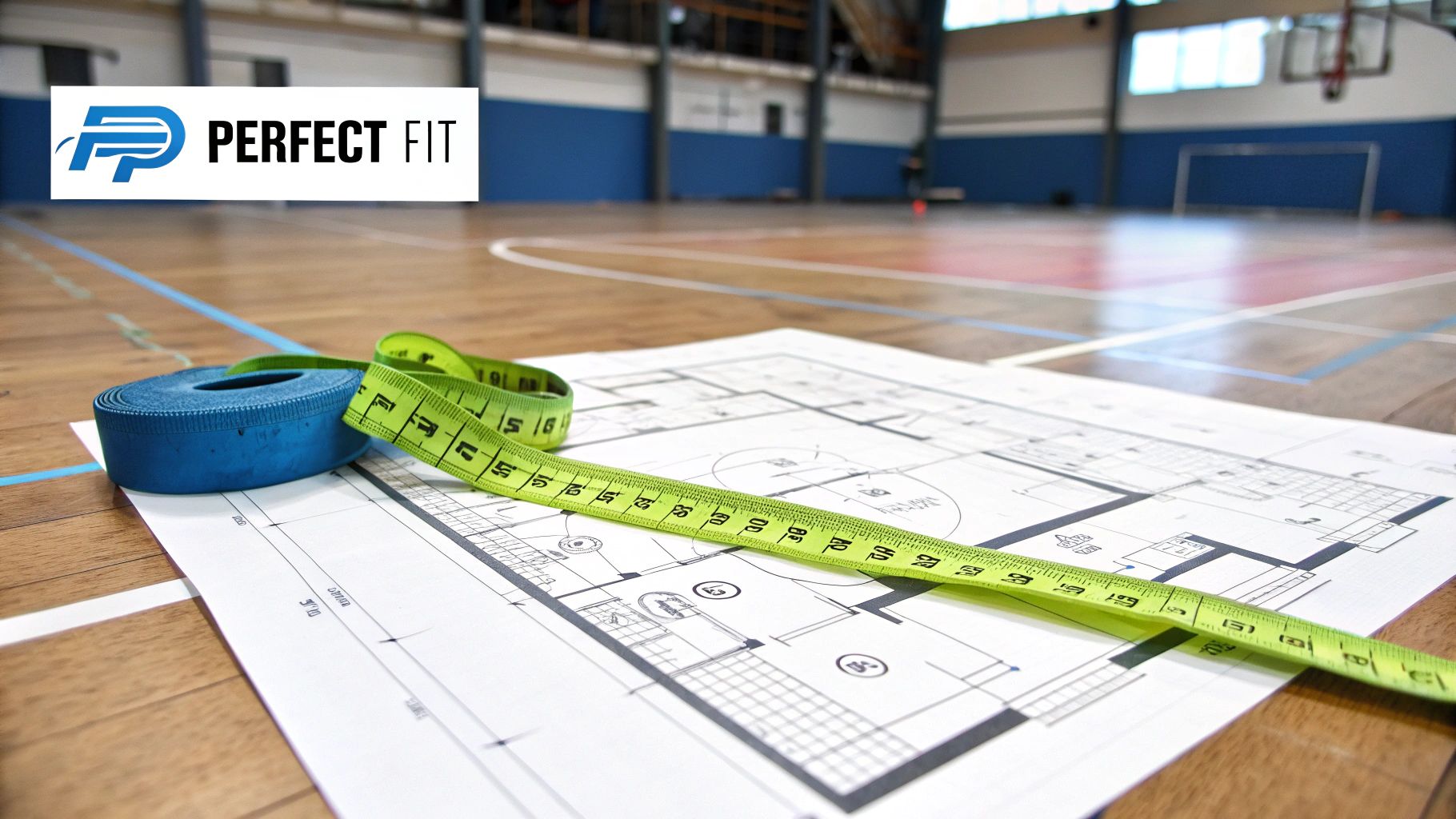
As you get closer to turning your vision for an indoor padel court into a reality, it's only natural for questions to start bubbling up. I've been there, and I've guided countless others through it. This final section is all about tackling those common queries we hear from aspiring club owners and investors every day.
We'll cut through the noise and get straight to the practical answers you need. From permits to upkeep, getting these details right is what separates a smooth project from a stressful one. Let's dive in.
What Is The True Lifespan Of An Indoor Court?
This is one of the first questions people ask, and for good reason—it’s all about your return on investment. The longevity of an indoor padel court really boils down to two things: the quality of the materials you choose and how consistently you maintain them. A top-quality court that's well looked after can easily last 10-15 years or even more.
The components you'll interact with most, the artificial turf and sand infill, have the shortest lifespan. Under heavy, daily use, you should plan to replace the playing surface every 5 to 8 years. This keeps performance high and ensures player safety. Regular brushing and redistributing the sand can definitely stretch that timeline.
The structural parts, on the other hand, are built for the long haul:
- Steel Frame: A properly galvanized steel structure is protected from the elements indoors. It should last for decades.
- Tempered Glass: The glass walls are incredibly tough. Unless they take a massive, direct hit, they'll last the entire life of the court.
I always tell clients to think of turf replacement as a predictable operational cost, not a sign of failure. If you budget for it from the start, it's never a surprise, and your facility will always feel premium to your players.
Do I Really Need A Permit For An Indoor Court?
The short answer is almost always a resounding yes. Even if you're building inside an existing warehouse or building, you're making significant structural changes. Local authorities will want to approve this. You're fundamentally changing how the space is used, which opens the door to a few different permits.
You'll almost certainly need a construction permit to ensure the court's structure is sound and meets local building codes. On top of that, you'll likely need electrical permits for the lighting system. Depending on your location, you might also need approvals for fire safety, accessibility (like ADA compliance), and zoning for a commercial recreational facility.
My best advice? Get in touch with your local building department as early as you can. It's not just a recommendation; it's essential for avoiding expensive delays or fines down the road.
How Much Maintenance Does An Indoor Court Actually Need?
Here’s some good news. One of the biggest perks of an indoor court is that it requires far less maintenance than an outdoor one. You're not battling rain, UV damage, or falling leaves. But "low maintenance" isn't the same as "no maintenance."
A simple, consistent routine is all it takes to protect your investment and keep players happy.
- Daily: A quick walk-through to spot any issues and wipe down the glass.
- Weekly: Brush the artificial turf. This is crucial for redistributing the sand, which keeps the fibers standing tall and gives you that perfect, consistent ball bounce.
- Monthly: A deeper clean of the glass and frame. Also, a good time to check the net tension and make sure all the bolts on the structure are tight.
- Annually: A deep clean of the turf and a check on the sand levels. Top it up if needed.
This routine doesn't take much time, but the payoff in court longevity and player experience is massive. A clean, well-maintained court is one of your most powerful marketing tools.
Can I Install A Court On My Own?
I get why people ask this—it looks like a chance to save some money. But unless you have direct, professional experience building these specific structures, I strongly advise against a DIY installation. Putting a padel court together is a job of precision, and getting it wrong affects both safety and how the game is played.
The process involves handling incredibly heavy tempered glass panels, making sure the steel frame is perfectly level and secure, and laying the turf and sand correctly to get a true bounce. A small mistake in any of these steps can result in an unsafe court, poor performance, or premature wear and tear.
Hiring a certified installation crew ensures the work is done correctly, protects your manufacturer's warranty, and frankly, lets you sleep at night.
Ready to turn your vision into a world-class padel facility? At Padel Rumors, we provide the most detailed guides, news, and resources to support every step of your journey. From exploring court options to connecting with the global padel community, we're here to help you succeed. Visit Padel Rumors to get started.


